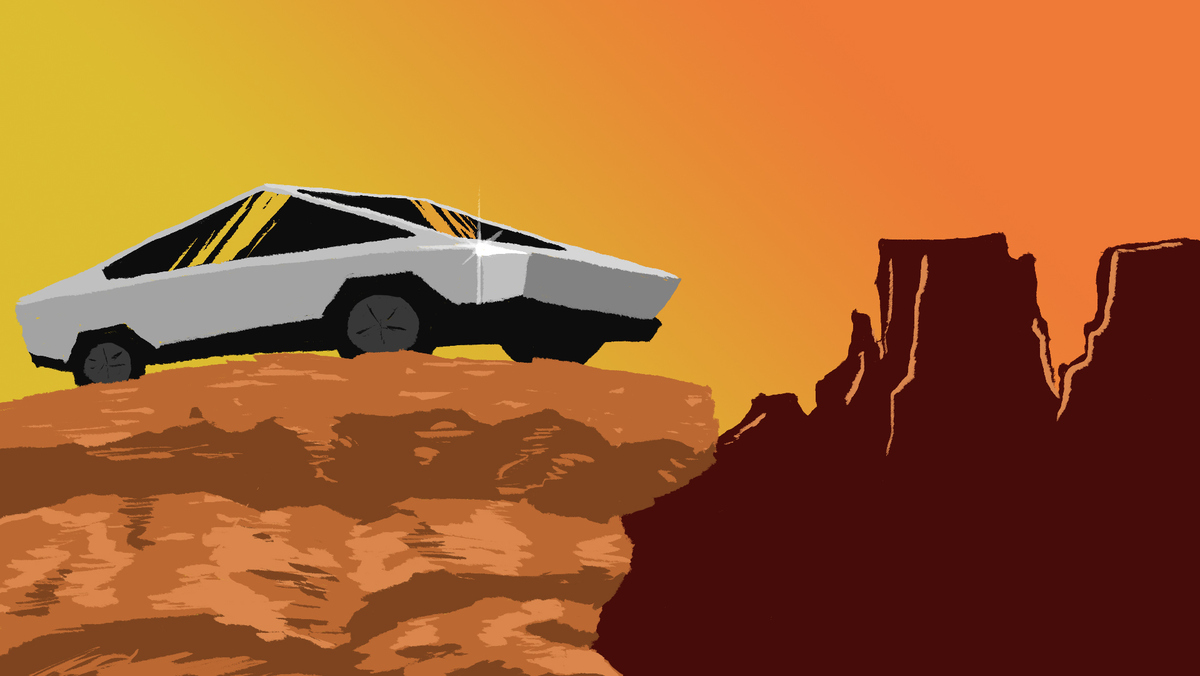Tesla’s controversial Cybertruck attempts to solve the issue of climate change with something akin to a war machine, which raises the question: is Tesla’s CEO Elon Musk’s vision of a greener future utopian or dystopian?
The Cybertruck has been compared to something out of a video game. Where the competition appeals to power fantasies common in cinema, Tesla’s new aesthetic appeals to the kind of power fantasy found in video games.
It’s not hard to imagine the car in action. It sails like a polygon from the screen of a retro arcade cabinet or the obelisk from 2001. The simple, smooth, reflective wedge careens through the city, frictionless. There is a purity about its quiet, electric, power. As it speeds along, unobstructed—like so many other car commercials—the crisp vision does not celebrate the beauty of a green Utopia. Instead, it says, “If you get in the way, this is going to do some serious damage.”
No matter how you spin it, the subtext is clear: “protect yourself.” With that comes an assumption of fear and other paranoid phenomenon. Implicit in that is “from who” or “what?”
Here we are focused on a consumer product, and in this way, Elon Musk is arming people with the world’s most powerful vehicle yet. The SUV, so popular in ‘90s and ‘00s has been likened to a tank. The Hummer, once a military standard vehicle, even traveled overseas from wars abroad to protect the American people from the conflicts at home.
The Cybertruck, with its indestructible windows and sledgehammer-proof metal, raises the bar. In the early 2000s, the conversation would end here with the Cybertruck as yet another manifestation of American fear and the desire for security in the face of 9/11. Make no mistake, the Cybertruck is a part of that legacy and all of its sinister roots, but in 2020, it finds itself in a new global context that cannot be ignored.
In the age of climate change, all of the above plays out at an emotional level. Tesla attempts to deconstruct the narrative of climate change and reconstruct it as a war to fight. Musk noticed that not only are people intellectually occupied with the threat of climate catastrophe, but they feel threatened by it as well. His response is to literally fight the threat with a product that is both powerful and green, tapping into the extreme ends of hope and fear. In this way the Cybertruck’s design both exacerbates fear and inspires the consumer with the confidence to deal with it.
The difficulty is, Musk’s new product acts as something like a pacifier; it distracts the consumer from the root problems of the automobile. Of the two things at play—climate change and power—Tesla attempts to brute force the first with the second. This solution doesn’t address the root problem nor the myriad other problems associated with urban living and cars and in fact, makes many of them worse. Congestion still rules the tempo of the city, parking spaces proliferate and streets are still not safe for people to walk in.
To the city, nothing has changed.
The Cybertruck is yet another automobile that governs its designs and layouts. While Musk’s solution “arms” us against climate change, imagine such a truck in the hands of outlaws or the police: With the Cybertruck’s superior speed, power and protection, could it be the next military vehicle? Could it become a standard in police departments across the country? After all, there is a lot of money to be made in any of these scenarios and all further the cause of climate change.
The conversation changes when one considers the possibilities of a city with no cars versus one that conforms to them. In the face of such philosophizing, the sturdy cybertruck deflates and joins its flaccid brethren that lazily maintain the status quo.
So what is the culmination of the cybertruck? Where is this indestructible speeding obelisk pointed? Towards utopia or dystopia? The future proposed by Tesla is benevolent in the sense that it seeks to make an emissionless future, and in that way, Musk strides towards utopia. But he does so without naivety and eviscerates the delusion imbued in other pickup trucks. Just like the futurists before him, the bright promise of tomorrow will come at bleak all consuming speed. But it has its limits.
To demolish and expose their faltering competition, Tesla had to embrace brawn and embody it in its extreme. This may paint a picture of a greener world but also a more violent one. Tesla’s new message is more desperate than ever, “whatever it takes,” and while the destination is sunny, the company’s way of getting there is anything but.
